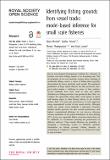Files in this item
Identifying fishing grounds from vessel tracks: model-based inference for small scale fisheries
Item metadata
| dc.contributor.author | Mendo, Tania | |
| dc.contributor.author | Smout, Sophie Caroline | |
| dc.contributor.author | Photopoulou, Theoni | |
| dc.contributor.author | James, Mark | |
| dc.date.accessioned | 2019-10-03T09:30:02Z | |
| dc.date.available | 2019-10-03T09:30:02Z | |
| dc.date.issued | 2019-10-02 | |
| dc.identifier | 261213520 | |
| dc.identifier | 23841e34-c4e9-41f3-8e1d-56150f261124 | |
| dc.identifier | 85074728267 | |
| dc.identifier | 000510431100050 | |
| dc.identifier.citation | Mendo , T , Smout , S C , Photopoulou , T & James , M 2019 , ' Identifying fishing grounds from vessel tracks: model-based inference for small scale fisheries ' , Royal Society Open Science , vol. 6 , no. 10 , 191161 . https://doi.org/10.1098/rsos.191161 | en |
| dc.identifier.issn | 2054-5703 | |
| dc.identifier.other | ORCID: /0000-0001-9616-9940/work/62668405 | |
| dc.identifier.other | ORCID: /0000-0002-7182-1725/work/62668410 | |
| dc.identifier.other | ORCID: /0000-0003-4397-2064/work/148888392 | |
| dc.identifier.uri | https://hdl.handle.net/10023/18605 | |
| dc.description | This study (T.M., M.J. and S.S.) was funded by the European Maritime Fisheries Fund ‘Scottish Inshore Fisheries Integrated Data System' (grant reference no. SCO1434). T.P. was supported by a Newton International Fellowship, funded by the Royal Society (grant reference no. NF170682). | en |
| dc.description.abstract | Recent technological developments facilitate the collection of location data from fishing vessels at an increasing rate. The development of low-cost electronic systems allows tracking of small-scale fishing vessels, a sector of fishing fleets typically characterized by many, relatively small vessels. The imminent production of large spatial datasets for this previously data-poor sector creates a challenge in terms of data analysis. Several methods have been used to infer the spatial distribution of fishing activities from positional data. Here, we compare five approaches using either vessel speed, or speed and turning angle, to infer fishing activity in the Scottish inshore fleet. We assess the performance of each approach using observational records of true vessel activity. Although results are similar across methods, a trip-based Gaussian mixture model provides the best overall performance and highest computational efficiency for our use-case, allowing accurate estimation of the spatial distribution of active fishing (97% of true area captured). When vessel movement data can be validated, we recommend assessing the performance of different methods. These results illustrate the feasibility of designing a monitoring system to efficiently generate information on fishing grounds, fishing intensity, or monitoring of compliance to regulations at a nationwide scale in near-real-time. | |
| dc.format.extent | 12 | |
| dc.format.extent | 754825 | |
| dc.language.iso | eng | |
| dc.relation.ispartof | Royal Society Open Science | en |
| dc.subject | Fishing activities | en |
| dc.subject | Spatial distribution | en |
| dc.subject | Small-scale fishery | en |
| dc.subject | Gaussian mixture model | en |
| dc.subject | Hidden Markov model | en |
| dc.subject | QH301 Biology | en |
| dc.subject | SH Aquaculture. Fisheries. Angling | en |
| dc.subject | DAS | en |
| dc.subject.lcc | QH301 | en |
| dc.subject.lcc | SH | en |
| dc.title | Identifying fishing grounds from vessel tracks: model-based inference for small scale fisheries | en |
| dc.type | Journal article | en |
| dc.contributor.sponsor | Scottish Government | en |
| dc.contributor.institution | University of St Andrews. Coastal Resources Management Group | en |
| dc.contributor.institution | University of St Andrews. School of Biology | en |
| dc.contributor.institution | University of St Andrews. Scottish Oceans Institute | en |
| dc.contributor.institution | University of St Andrews. Sea Mammal Research Unit | en |
| dc.contributor.institution | University of St Andrews. Centre for Research into Ecological & Environmental Modelling | en |
| dc.contributor.institution | University of St Andrews. Marine Alliance for Science & Technology Scotland | en |
| dc.identifier.doi | 10.1098/rsos.191161 | |
| dc.description.status | Peer reviewed | en |
| dc.identifier.grantnumber | SCO1434 | en |
This item appears in the following Collection(s)
Items in the St Andrews Research Repository are protected by copyright, with all rights reserved, unless otherwise indicated.

